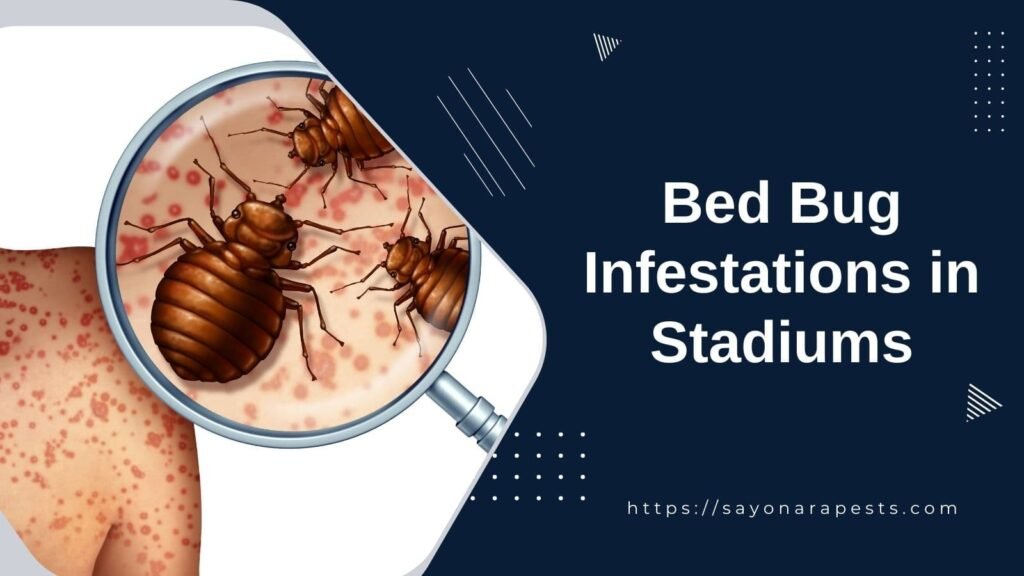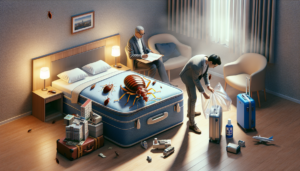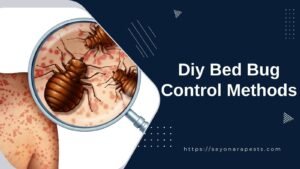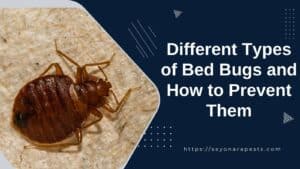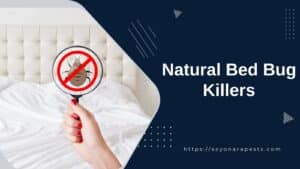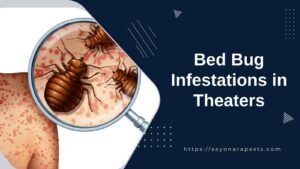Understanding Bed Bug Infestations
Bed bugs have become a formidable pest in various environments, including homes, hotels, and even stadiums. Understanding the nature of these infestations is the first step in addressing this challenge effectively.
Impact on Public Health
Bed bug infestations are more than just a nuisance; they are recognized as a significant public health issue. While bed bugs are not known for transmitting diseases, their presence can lead to various adverse health outcomes.
These pests can cause negative physical and mental health consequences. Individuals may suffer from allergic reactions to bites, leading to discomfort and sleep disturbances.
Beyond the physical implications, the psychological impact is profound, triggering anxiety, nightmares, and other stress-related disorders.
Factors Contributing to Infestations
Several factors contribute to the rise of bed bug infestations in stadiums and other public spaces.
One such factor is the increased mobility of people; as individuals travel from one place to another, bed bugs hitch rides on luggage, clothing, and personal belongings, spreading infestations.
Additionally, the cost of effective pest control can be prohibitive. Pest management firms report spending billions of dollars annually to combat these pests.
The economic burden often means that infestations go untreated, particularly in disadvantaged communities, leading to a persistent problem that can affect entire cities.
Historical records show that bed bugs have been a persistent issue since the European colonies, with various extermination techniques being used throughout the centuries (The Big Green K).
Cities with the highest reports of bed bug encounters include New York City, Baltimore, and Washington D.C, among others, indicating a widespread infestation problem that continues to grow.
The table below shows the percentage increase in bed bug-related calls since 2002, highlighting the severity of the issue.
| City | Percentage Increase |
|---|---|
| New York City | 85% |
| Baltimore | 83% |
| Washington D.C. | 81% |
For those dealing with bed bug infestations, it is crucial to understand the various ways to kill bed bugs, including killing them with heat, using steam, and applying diatomaceous earth.
It’s also essential to learn about preventing bed bugs when traveling and how to check for bed bugs in hotel rooms.
There are numerous professional bed bug treatment options available that can effectively address these infestations, ensuring that public spaces like stadiums remain safe and comfortable for everyone.
Preventing Bed Bug Infestations
Preventing bed bug infestations is a crucial step for homeowners, renters, hoteliers, and Airbnb operators alike. Understanding how these pests spread and taking proactive measures can significantly reduce the likelihood of an infestation.
Travel-Related Causes
Traveling is a leading cause of bed bug infestations, with hotels, motels, and Airbnb accommodations being common hotspots for these pests.
Bed bugs can easily hitch a ride on luggage, clothing, or personal items if they come into contact with infested furniture. To prevent bringing bed bugs home, travelers should:
- Inspect hotel room beds, furniture, and luggage stands for signs of bed bugs.
- Use luggage racks to keep suitcases off the floor and away from potential infestation sites.
- Check luggage before leaving and upon returning home.
- Consider using protective covers for suitcases or storing them in bags when not in use.
For more detailed guidance on how to avoid bed bugs while traveling, visit our article on preventing bed bugs when traveling.
Furniture Acquisition Risks
Second-hand furniture is another common vector for bed bug introductions into the home. When purchasing or accepting used furniture, it’s important to:
- Thoroughly inspect all furniture for signs of bed bugs or their eggs, especially in seams, crevices, and hidden areas.
- Avoid acquiring mattresses, box springs, and upholstered furniture from unknown sources if possible.
- Consider treating second-hand furniture with heat or insecticide before bringing it into the home, especially if the history of the item is uncertain.
Learn how to check for and deal with infestations in second-hand furniture through our article on using heat to kill bed bugs.
Common Transfer Points
Bed bugs can also spread in communal settings, such as schools, colleges, and daycare centers.
They can cling to clothing, backpacks, and other personal items, facilitating their movement into homes. To minimize the risk of transfer, individuals should:
- Be vigilant in places where bed bugs are known to be prevalent.
- Encourage regular cleaning and vacuuming of personal items and spaces.
- Educate children and family members about the risks of bed bugs and how to identify them.
- Use protective covers for mattresses and box springs to prevent bed bugs from taking up residence.
For strategies on preventing bed bugs from spreading, including the use of diatomaceous earth and other methods, explore our resource on preventing bed bugs from spreading.
By being aware of the travel-related causes, furniture acquisition risks, and common transfer points of bed bug infestations, individuals can take steps to safeguard their environments.
Staying informed and vigilant is key to keeping living spaces bug-free. For more information on eliminating bed bugs, check out our comprehensive guide on ways to kill bed bugs.
Identifying Bed Bug Infestations
Identifying a bed bug infestation early is crucial to prevent the pests from spreading and to minimize the impact on those affected.
Below are the signs and symptoms to look out for, the environments where infestations are most likely to occur, and the reactions caused by bed bug bites.
Signs and Symptoms
The presence of bed bugs can be quite difficult to detect as they are nocturnal and small in size. However, there are several telltale signs that indicate an infestation:
- Live bed bugs: Although small, adult bed bugs are visible to the naked eye and are typically the size of an apple seed.
- Dark spots: These may appear on bedding or clothing and are often bed bug excrement.
- Stains on mattresses or sheets: Rusty or reddish stains could be caused by crushed bed bugs.
- Eggs and eggshells: Tiny and pale yellow skins that nymphs shed as they grow larger.
- Foul odor: A musty, offensive smell often emitted from their scent glands.
| Sign | Description |
|---|---|
| Live Bed Bugs | Adults are brownish and approximately the size of an apple seed. |
| Dark Spots | Bed bug excrement that may appear on bedding or clothing. |
| Stains | Rusty or reddish stains on bed sheets or mattresses from crushed bed bugs. |
| Eggs and Eggshells | Tiny, pale yellow skins found in mattress folds and sheets. |
| Foul Odor | Musty, offensive smell from bed bugs’ scent glands. |
For more details on these signs, visit Army.mil.
High-Risk Environments
Bed bugs are not limited to any particular environment, as they can thrive in any place where humans dwell. High-risk environments include, but are not limited to:
- Lodging facilities such as hotels and motels, where there is a high turnover of guests (how to check for bed bugs in hotel rooms)
- Public transportation, including buses, trains, and planes
- Public seating areas like those found in theaters, airports, and now increasingly, in stadiums
- Shared living spaces and communal shelters
To prevent unwittingly inviting bed bugs into your home or business, learn about preventing bed bugs when traveling and preventing bed bugs from spreading.
Bed Bug Bite Reactions
Bed bug bites can manifest in a variety of ways and may not be immediately apparent, as bites can take a few days to cause a reaction. Symptoms include:
- Cutaneous reactions: These can range from minor reactions to large wheals and are often accompanied by intense itching.
- Bullous eruptions: In some cases, bites may lead to bullous eruptions containing clear or bloody exudate.
- Anemia and asthmatic reactions: Serious reactions can include anemia from numerous bites and asthmatic reactions triggered by bed bug allergens.
- Pathogens: Over 40 pathogens have been detected in bed bugs, but there is currently no conclusive evidence that they transmit diseases to humans.
The following table summarizes the potential reactions to bed bug bites:
| Reaction Type | Description |
|---|---|
| Cutaneous Reactions | Small red lesions that can develop into large wheals with intense itching. |
| Bullous Eruptions | Eruptions containing clear or bloody exudate may occur. |
| Anemia | May occur when bed bugs are numerous. |
| Asthmatic Reactions | Bed bug allergens can potentially trigger asthma attacks. |
For a comprehensive understanding of bed bug bite reactions, refer to information from PubMed Central and NCBI.
Detecting bed bug infestations is a critical step towards implementing effective control measures. Once identified, explore ways to kill bed bugs, including using steam, diatomaceous earth, and professional bed bug treatment options.
Effective Bed Bug Control Methods
Successfully managing bed bug infestations, particularly in places like stadiums where there is a high volume of human traffic, requires a mixture of diligent practices and professional intervention.
Here we will discuss the best strategies for maintaining a bed bug-free environment.
Cleaning and Laundering Practices
One of the foundational steps in preventing and controlling bed bug infestations is maintaining good cleaning habits.
Regular cleaning of your home, including weekly washing of sheets, is crucial. Items should be laundered at high temperatures and dried on a high heat setting to kill any bed bugs present.
Frequent vacuuming can help remove bed bugs from floors, furniture, and other surfaces, while reducing clutter in your space removes potential bed bug hiding spots.
When traveling, which is a common way bed bugs spread, inspect sleeping areas with a flashlight and refrain from placing luggage on furniture.
Always examine the seams and folds of beds for signs of bed bugs (preventing bed bugs when traveling).
| Cleaning Practice | Purpose |
|---|---|
| Wash and dry bedding weekly | Kill bed bugs with high heat |
| Frequent vacuuming | Remove bed bugs and eggs from surfaces |
| Minimize clutter | Reduce hiding places for bed bugs |
| Inspect beds while traveling | Prevent bringing bed bugs home |
Professional Extermination
In the event of a bed bug infestation, it is often necessary to seek professional help. Exterminators are equipped with the tools and knowledge required to effectively eliminate bed bugs.
Techniques such as killing bed bugs with heat, using steam, and insecticides are part of the professional arsenal against these pests. Mattress and box spring encasements can also be used to trap and starve any remaining bed bugs after treatment.
Professionals may employ a combination of chemical and non-chemical methods, ensuring a comprehensive approach to eradication.
For information on the variety of professional treatment options available, visit professional bed bug treatment options.
Challenges in Bed Bug Control
Despite advancements in pest control technology, bed bugs remain one of the most challenging insects to manage. Their resistance to various insecticides, coupled with their elusive nature, makes eradication difficult. Control is also made more challenging by the costs associated with treatment, which can be prohibitive, particularly for those from lower socioeconomic backgrounds.
Infestations are often unreported or untreated in disadvantaged communities, turning these areas into reservoirs for bed bugs. This underscores the importance of accessible and effective control options for all segments of society. To explore more about the intricacies of bed bug control, including common misconceptions, check out bed bug myths and facts.
For those interested in natural or DIY methods, resources such as natural remedies for killing bed bugs and diy bed bug control methods provide additional guidance.
However, it’s important to remember that while DIY methods can be helpful, they may not always be as effective as professional extermination, particularly for large infestations like those that might occur in stadiums or other public spaces.
Historical Perspective on Bed Bugs
The history of bed bugs is as old as human civilization, with these pests having been a constant, albeit unwanted, companion through the ages. However, the dynamics of bed bug infestations have changed over time due to various factors.
Resurgence Factors
Bed bugs experienced a dramatic resurgence in the latter part of the 20th century. The banning of DDT in the 1970s, a potent insecticide used to control these pests, is often cited as a turning point. This ban, due to health and environmental concerns, left a void in effective bed bug control measures. Additionally, the 1990s marked the beginning of a full comeback for bed bugs, propelled by increased domestic and international travel and a general lack of public awareness about these pests.
Furthermore, the resurgence of bed bugs involves two species: the common bed bug (Cimex lectularius) and the tropical bed bug (Cimex hemipterus).
A confluence of factors, such as resistance to common insecticides, the global spread of resistant bed bugs due to international travel, and subpar pest control practices, have exacerbated the problem.
Other contributing factors include inadequate training among pest control technicians in handling resistant bed bugs, slow development of management standards by industry associations, and regulatory failures in ensuring the efficacy of insecticide products against current field strains.
Global Infestation Trends
The last few decades have seen a significant increase in bed bug infestations worldwide. Pest management firms reported an 81% increase in bed bug-related service calls since 2002.
In the United States, approximately 1 in 5 Americans have encountered bed bugs in their living spaces or know someone who has.
The cities most impacted by this resurgence include New York City, Baltimore, Washington D.C., Cincinnati, Columbus, Detroit, Chicago, Dallas, Los Angeles, and San Francisco.
Globally, the early 21st century has seen infestations rise sharply, with professional pest managers in Australia reporting a surge by over 4,500%. The Americas, Europe, Asia, and Africa have all reported growing numbers of infestations, signaling a truly global issue.
For those seeking to understand and combat these pests, it is essential to explore ways to kill bed bugs, such as killing bed bugs with heat, using steam, diatomaceous earth, freezing, and professional extermination methods like vacuuming and insecticides.
Furthermore, understanding what attracts bed bugs to your home and preventing their spread is crucial. For professional solutions, consider professional bed bug treatment options.
The historical context of bed bug infestations provides insight into the complexity of managing these pests today.
Knowledge of past struggles and current trends is crucial for individuals and professionals, including homeowners, renters, hoteliers, and Airbnb hosts, to effectively address and prevent infestations in their environments.
Bed Bugs and Human Health
The concern over bed bug infestations extends beyond the inconvenience of an infestation; these pests can also have various impacts on human health, ranging from psychological effects to clinical manifestations and potential disease transmission risks.
Psychological Effects
The psychological impact of bed bug infestations is substantial. Individuals dealing with bed bugs often experience heightened anxiety, nightmares, and even phobias associated with the infestation.
These psychological disorders can lead to hypervigilance, where one constantly checks for signs of infestation, and insomnia, caused by the fear of being bitten at night.
The stress of an infestation can also affect a person’s self-esteem and may lead to social isolation due to the stigma of having bed bugs. The socioeconomic burden of bed bug infestations on society is significant, as it can influence mental health and productivity.
Understanding these effects is critical for those managing bed bug infestations in stadiums and other public spaces.
Clinical Manifestations
Bed bug bites manifest in various ways on the skin. While some individuals may only have minor reactions, others can develop maculopapules, papules, nodules, or even more severe conditions like vesicles, bullae, and erythema. Itching can be intense, and the urge to scratch can lead to secondary infections.
In rare cases, individuals may experience systemic allergic reactions, including asthmatic reactions, urticaria, and anaphylaxis.
The clinical manifestations can be distressing and may require medical attention, emphasizing the importance of effective bed bug extermination methods.
Disease Transmission Risks
Though bed bugs are known for their blood-sucking habits and the cutaneous reactions they cause, the risk of disease transmission to humans has not been conclusively proven.
While over 40 pathogens have been detected in bed bugs, there is no definitive evidence that they transmit disease-causing organisms.
However, the allergens produced by bed bugs can trigger asthmatic reactions, and in situations where bed bugs are numerous, there is a potential for anemia due to the volume of blood loss.
Given these risks, learning ways to kill bed bugs and preventing bed bugs from spreading is of paramount importance for maintaining public health.

